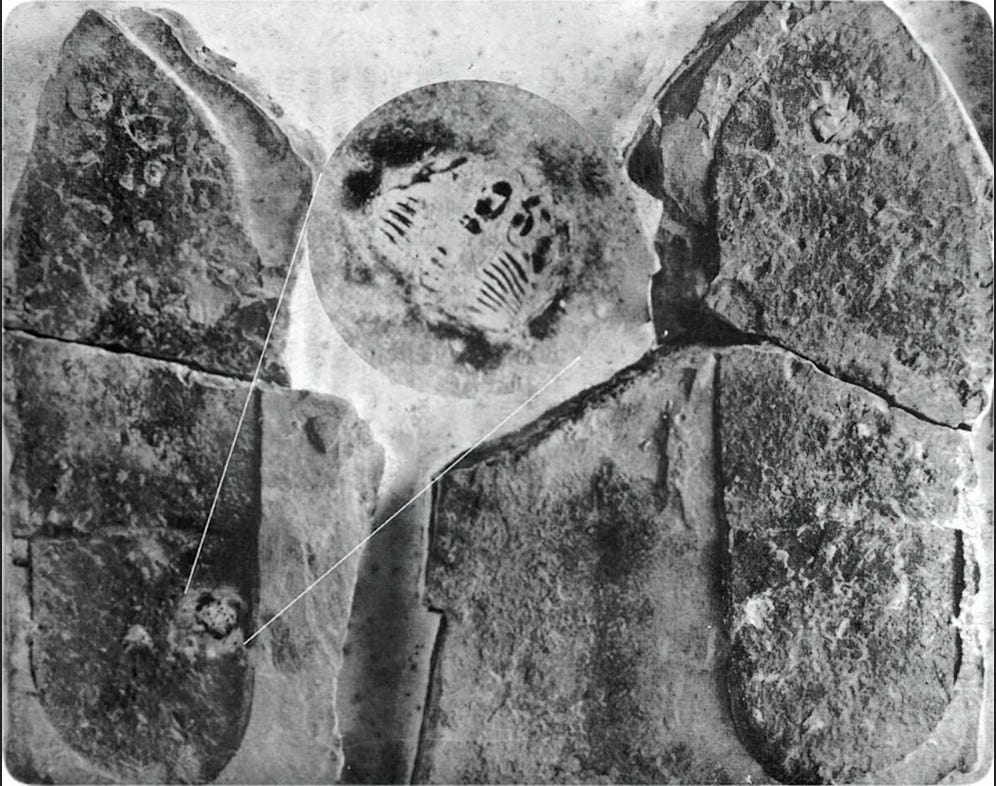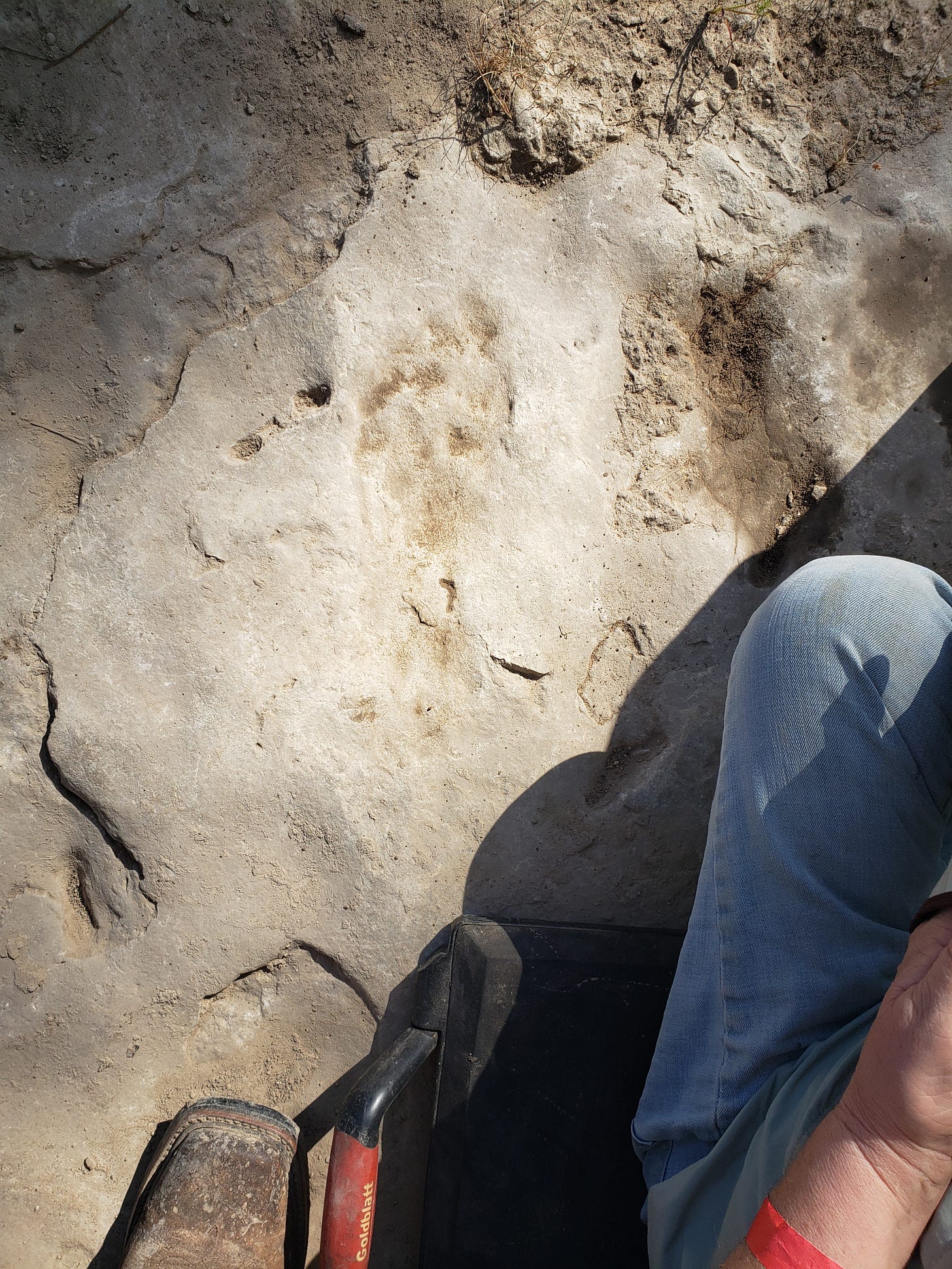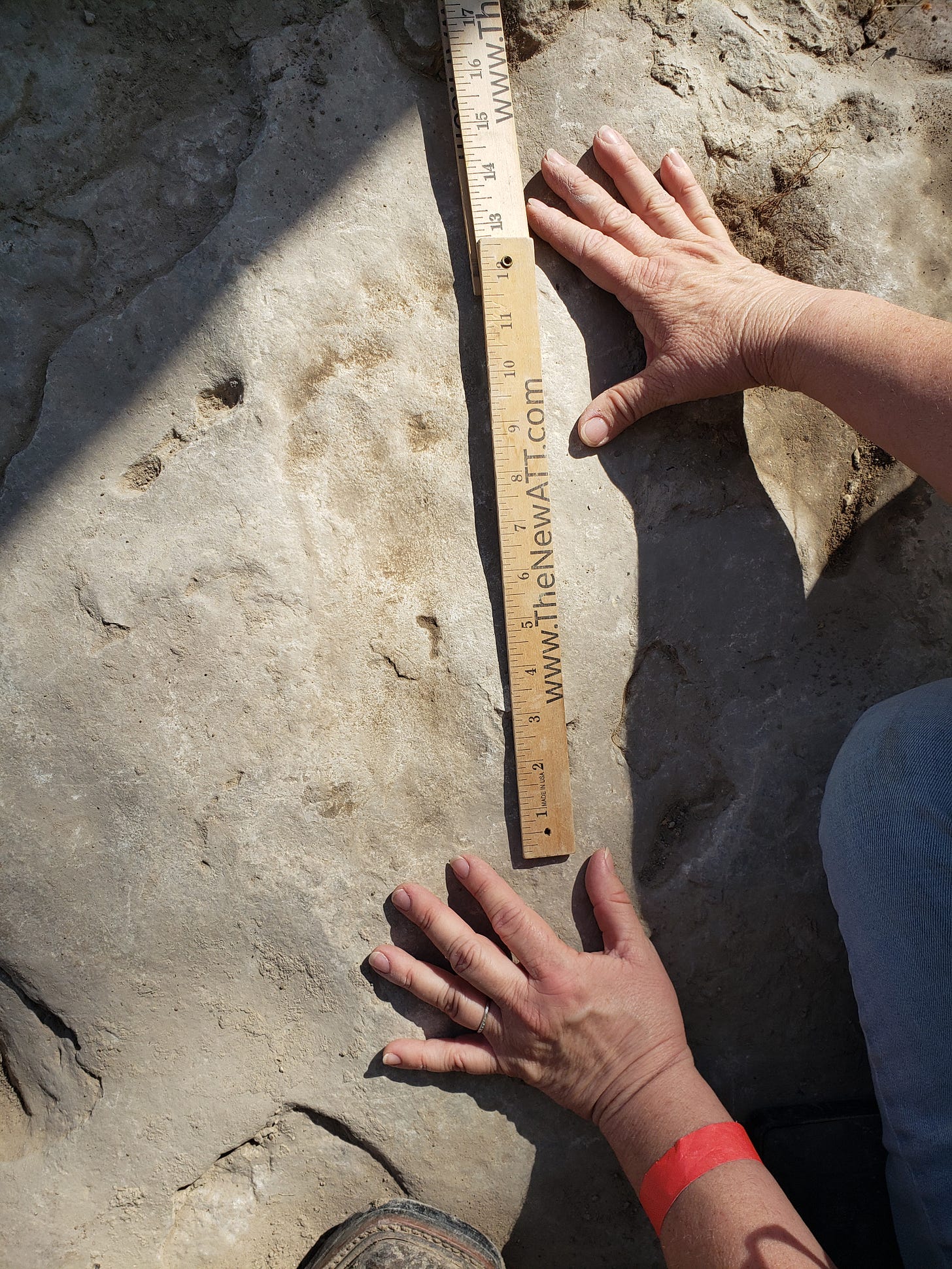The Zapata Track and Permian Footprints
Another controversial footprint is the Zapata Track, found in Permian limestone in New Mexico. The rock — which belongs to the Permian Period 299 to 251 million years ago — was discovered in New Mexico, yet the track appears to be a clear human footprint. Curiously, the Permian (along with the Paleozoic) ended with the Permian–Triassic extinction event, the largest mass extinction in Earth’s history. Nearly 90% of marine species and 70% of terrestrial species died out. The footprint is very shallow and only visible when wet under strong side lighting, which explains its hourglass shape with dots in front. Laboratory tests indicated that the rock was limestone with 30% silica, making carving highly unlikely.
In 1987, paleontologist Jerry MacDonald discovered a large number of fossil footprints in the same Permian strata at Robledo Mountain, New Mexico. These well-preserved tracks included various unusual prints, some resembling human footprints. Smithsonian Magazine reported on the discovery, noting that the tracks included a variety of "problematica" that defied conventional classification, including three-toed prints from animals unknown to science and some that appeared to be from creatures walking on two legs.
Zapata Fossil Footprint
Other Anomalous Footprints
The Meister Print: Discovered in Utah within a block of Cambrian shale, this print gained attention for allegedly containing a trilobite fossil. A child's footprint was also reportedly found at the site.
In 1968, William J. Meister made a remarkable discovery now known as the “Meister Print.” The print appears to resemble a footprint left by someone wearing a primitive shoe or sandal. Meister uncovered this impression during a fossil-hunting expedition at Antelope Spring, Utah. According to his account, while searching for fossils with his family, he split open a two-foot slab of rock—revealing the footprint embedded within.
What makes this find particularly intriguing is that the individual who left the imprint seemingly stepped on a living trilobite, a marine arthropod that existed over 500 million years ago. The trilobite remains visible within the footprint. The print itself measures 10 ¼ inches in length and 3 ½ inches in width, with a distinct heel impression toward the back.
In the accompanying image, the print can be seen on the left, while its impression appears on the right. The crushed trilobite is located near the heel of the footprint.
Meister claimed that after his discovery, a geologist examined the print and offered him $250,000 for it. When Meister asked what he intended to do with it, the geologist allegedly responded, “I’m going to destroy it. It undermines my entire life’s work as a geologist.”
Meister Print
The Berea College Track: In Kentucky, a fossilized human-like track was reportedly discovered in Upper Carboniferous sandstone. Numerous scientists examined the footprint, confirming that the sand grains at the bottom were compressed, making carving unlikely. Scientific American geologist Albert G. Ingalls commented that if these prints were genuine, they would overturn the entire field of geology.
Possible Fossil Human Footprint discoverd on the Paluxy River- 2023
Author standing at the end of the Taylor Trail- Paluxy River, Glen Rose, TX 1999
Human fossil footprints present a huge problem and threat to the scientific community.
Here’s why:
1.) If the tracks are millions of years old, why haven’t they eroded away millions of years ago? Running water over a print for 65 million years should have erased these prints so long ago. Since they were not eroded away, could it mean that they were placed down recently – perhaps only a few thousand years ago? See my presentation “Preponderance of Evidence for a Young Earth”.
2.) Dinosaur tracks are found in the same limestone strata as the human fossil footprints. This indicates that dinosaurs and men lived at the same time and not 60 million years apart as evolution teaches!
3.) A human with a seven foot stride and 21 inch feet means that at least one 12 foot giant man lived at some point in prehistory.
What if the footprints are from a modern human?
The implications of the Paluxy river footprints are significant;
A) Evolution is a false narrative.
B) Greater confidence can be put in the book of Genesis, which states that God created all living things in 6 days.
C) Modern human footprints in stone agree with the Genesis account.
Order the PDF book: Evolution and Human Fossil Footprints here
PS. If you loved this article, be sure to head over to our Ancient Pathways Patreon site. This is only a brief introduction to this intriguing subject of human footprints in stone. See the original 16mm film, “Footprints in Stone”, the new “Footprints in Stone: Forbidden History” and our “Out of Place Fossils Digital Library!
References
Morris, J. (1980). Tracking Those Incredible Dinosaurs (and the People Who Knew Them).
Helfinstine, R., & Roth, J. (1994). Texas Tracks and Artifacts.
Leakey, M., & Hay, R. L. (1979). Pliocene Footprints in the Laetolil Beds at Laetoli, Northern Tanzania. Nature, 278(5702), 317–323.
Patton, Don (Personal report on the Zapata track extraction attempts).
Smithsonian Magazine, Vol. 23, July 1992, p. 70.
Auldaney, Rosnau, Back, & Davis, (1995). CRS Quarterly, Vol. 34, pp. 133-146.
Ingalls, A. G. (1940). Scientific American, Vol. 162, No. 6, pp. 14-18.










